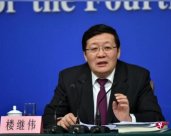
Former Chinese Minister of Finance Lou Jiwei said that the Chinese budget deficit rate broke through 3 % for the first time in 2020 in 2020.Special national debt issued by the government during the epidemic can achieve the same goal by increasing the rate of deficit.
Former Chinese Minister of Finance, Lou Jiwei believes that the Chinese government does not have to obey to maintain the budget deficit rate within 3 %, and should decide the deficit rate according to the economic situation at that time.
Lou Jiwei suggested that China increased the budget deficit rate to more than 3 % last month.When asking, further explaining that the government's anti -epidemic bonds issued by the government during the epidemic can achieve the same goal by increasing the rate of deficit.
China's deficit ratio exceeded 3 % in 2020, which was out of the crown disease, and increased from 2.8 % in 2019 to 3.7 %.Subsequently fell to 3.1 % in 2021, and further reduced in 2022 to about 2.8 %.
Lou Jiwei admits that China has a faith that cannot exceed 3 %.This provision was actually set by the European Union as a member country, but France and other countries have broken through this boundary.He added that two US President Trump and the Biden government set too high deficit rates, and may also exacerbate inflation problems, "but there is no need to obey at 3 %."
He takes the official government bond of 1 trillion yuan (RMB, S $ 196.6 billion) issued by the officially issued in 2020 as an example.Increase a percentage deficit rate for the budget of the year.
"Is that the right rate of a percentage point is not over? There is no need to stay 3 % to be 3 %."
The pilot pilot of real estate tax due to the downturn in the property market should be carried out as soon as possible
Lou Jiwei also suggested that the expansion of real estate tax expanded due to the coldness of the property market should be carried out as soon as possible after the economic transformation to normal growth; this can not only bring additional fiscal revenue to China, but also help reduce urban and rural areasThe gap between income and promoting common prosperity.
China was decided to launch a five -year real estate tax reform pilot in some regions at the end of 2021, and to formulate laws when the conditions are mature.However, with the crisis of liquidity in the property market, the Ministry of Finance of China announced last March that it was "no conditions for expanding the pilot cities of real estate tax reform."
Lou Jiwei pointed out that the biggest difficulty in the legislation of real estate tax reform is that a large number of housing property rights and limited transactions have caused difficulty valuations, which is because urban and rural areas implement different land systems.
Urban enterprises and residents have the right to transfer land and real estate at the market price, and the valuation is relatively simple.The rural land is collectively owned, and farmers have the right to use the house site but the transfer of transfer is limited. Many people build a house and sell it on the homestead. The thus formed brings a difficult problem for the valuation.
In the pilot of real estate tax reform, exploration can be carried out in conjunction with the reform of the land system.
When answering the question of how China promotes common prosperity, Lou Jiwei said that China's current largest income gap is the urban -rural income gap caused by the dual structure of urban and rural land and the dual architecture of the household registration system.If the urban and rural dual structure can be reformed, it is expected to reduce the Chinese Gini coefficient (comprehensive indicators to measure the gap between residents' income) from the current 0.466 to 0.4.
Reform of the dual architecture of urban and rural areas can reduce the income gap
Due to the restrictions on household registration, the rural household registration population is more difficult to enter the city.Lou Jiwei said that the permanent population in the countryside accounts for more than 30 % of China's population, while agricultural added value accounts for less than 8 % of the GDP (GDP)."30 % of the population contribute 8 % of GDP, and the income must be low."



